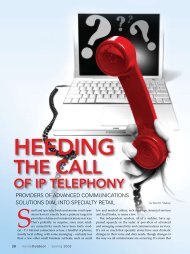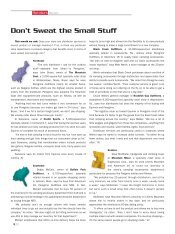CLOUD COMPUTING AND THE FUTURE OF RETAIL
CLOUD COMPUTING AND THE FUTURE OF RETAIL
CLOUD COMPUTING AND THE FUTURE OF RETAIL
You also want an ePaper? Increase the reach of your titles
YUMPU automatically turns print PDFs into web optimized ePapers that Google loves.
Cloud<br />
Form<br />
Cloud computing and<br />
the future of retail<br />
by Martin Vilaboy<br />
Partly because of the inherent complexities<br />
and partly due to overzealous<br />
marketing, any discussion of “the<br />
cloud” should probably start with a<br />
clarification of what exactly “cloud<br />
computing” means to technology decision<br />
makers. Some have said the cloud is simply a euphemism<br />
for the Internet. Others argue that it’s really<br />
nothing new but rather just a return to “centralized”<br />
versus “distributed” computing, made accessible now<br />
by the ubiquity of high-speed data networks.<br />
As much truth as there may or may not be in<br />
these oversimplifications, neither should be used as<br />
an excuse to disregard the importance of what the<br />
cloud is and can do, particularly when it comes to<br />
the retail business. As it turns out, many of the benefits<br />
wrought by moving IT components to the cloud<br />
directly address the daunting challenges and macro<br />
trends facing retail IT departments today. In fact, it’s<br />
even possible that the retail segment, at least in the<br />
short term, has more to gain from the cloud trend<br />
currently sweeping the IT world than most any other<br />
industry vertical. Indeed, many retail analysts and experts<br />
believe that a transition to the cloud could prove<br />
necessary to individual retailer’s survival long term.<br />
Getting back to the beginning, The National Institute<br />
of Standards and Technology, for its part, defines<br />
cloud computing as, “a model for enabling convenient,<br />
on-demand network access to a shared pool<br />
of configurable computing resources (e.g., networks,<br />
servers, storage, applications and services) that can be<br />
rapidly provisioned and released with minimal management<br />
effort or service provider interaction.”<br />
NIST’s definition may or may not clear things<br />
up. If not, most specialty retailers can think of cloud<br />
computing as a model by which computing and IT<br />
services and capabilities can be accessed anywhere,<br />
on any device, through the Internet. That differs<br />
from the traditional IT delivery model, whereby<br />
hardware, such as servers and storage devices, as<br />
well as software purchased through a license, would<br />
reside at the physical location at which they are being<br />
used. In the cloud, on the other hand, equipment and<br />
business applications are housed on servers in large<br />
data centers where a paid or “for-free” provider hosts<br />
14 | InsideOutdoor | Spring 2011
Ongoing concerns about solution<br />
vendor or service provider stability<br />
and longevity<br />
We don’t like sharing our<br />
innovations with outsiders<br />
Source: RSR Research<br />
18%<br />
5%<br />
16%<br />
9%<br />
0 10 20 30 40 50 60 70 80<br />
ations<br />
How much do each of the following factors influence how<br />
your company’s technology portfolio will change?<br />
We want to spend less time on “catch up”<br />
investments in IT, and spend more time<br />
differentiating with IT-enabled capabilities<br />
52%<br />
48%<br />
We need to shorten the lead time<br />
to customer demand fulfillment<br />
47%<br />
48%<br />
and manages the solutions, as well<br />
Rapid<br />
as<br />
consumer<br />
cloud<br />
adoption<br />
or engage<br />
of new<br />
a third-party provider at Retail Systems 47%<br />
technologies such as “smart mobile”,<br />
Research, with the<br />
the user’s experience with “social them. media”, Cloud etc. is forcing to host us and to “go manage faster” it – either on site or user having 34% no knowledge or concern of<br />
services ranging from raw infrastructure off. A private cloud provides restricted where any individual piece resides.<br />
We need to overcome an ingrained “not<br />
41%<br />
to complete business processes invented (email, here” attitude access and take to the advantage computing capabilities and “This is different than a simple hosted<br />
of what’s commercially available<br />
31%<br />
accounting, CRM, scheduling, forecasting,<br />
resources to be shared only by employ-<br />
application accessed remotely,” says RSR.<br />
as examples) are purchased and ees or external partners, such as distrib-<br />
“Parts could well reside on a local device.<br />
We need to reduce ongoing maintenance<br />
41%<br />
accessed through Web interfaces. costs associated with utors owning and manufacturers.<br />
solutions<br />
It’s completely location 45% agnostic.”<br />
That might sound a lot like how<br />
Most retailer deployments up to this<br />
we’ve come to know and use the Internet,<br />
point, suggest findings from<br />
Winners<br />
Accenture, involve<br />
OthersCut and Paste<br />
you might say. In many ways, this<br />
is precisely how routed networks based<br />
on Internet protocol (IP) work, and the<br />
pervasiveness of high-speed access is<br />
largely what makes cloud computing so<br />
powerful. But before you start cringing<br />
over the idea of placing your customer<br />
data or communications services on the<br />
either a private cloud or some type<br />
of Source: “hybrid RSR model,” Researchthe managed combination<br />
of both private and public clouds.<br />
“So, for example, low level data and<br />
access may well be suitable to go onto a<br />
public cloud infrastructure service with<br />
simple password access, whereas ultra<br />
The primary promises of the cloud<br />
include enhanced flexibility and speed<br />
at significantly lower costs, and few<br />
vertical markets need to drive such advantages<br />
out of their IT infrastructures<br />
during the next several years more than<br />
retail/wholesale.<br />
wild and open Internet, it’s first important<br />
to have an understanding of the<br />
differences between the “public cloud”<br />
The shopper is better connected to consumer information<br />
than store associates.<br />
(Percentage of responding retail employees)<br />
and a “private cloud.”<br />
According to executives at IBM, the<br />
Completely<br />
Agree<br />
Neutral Disagree Completely<br />
Agree<br />
Somewhat<br />
Somewhat Disagree<br />
infrastructure in a public cloud is owned<br />
and managed by an organization selling<br />
cloud services and is made available to<br />
the general public. In this model, computing<br />
capabilities typically are accessed<br />
17% 37.5% 26.1% 15.3% 4.1%<br />
by multiple subscribing clients on a flexible,<br />
pay-per-use basis.<br />
Most people associate the public<br />
cloud with “community-based” offerings<br />
0%<br />
Source: Motorola Solutions<br />
50% 100%<br />
accessed over the public Internet,<br />
such as Google Apps, explains Joe<br />
Corvaia, vice president of solution<br />
engineering at cloud services provider<br />
Broadview Networks.<br />
secure data may require dedicated secure<br />
servers housed in ultra-secure data centers<br />
with strong authentication required<br />
for access,” explain Accenture analysts.<br />
Cloud computing also differs somewhat<br />
For starters, the retail industry<br />
doesn’t like to spend a lot on technology.<br />
Retail IT operating budgets, as a percentage<br />
of revenue, are typically among<br />
the lowest of all the major industries,<br />
from for the Using purely the “centralized Cloud com-<br />
The infrastructure in a private Initial cloud, Opportunities<br />
and we don’t expect that many retail<br />
on the other hand, is operated solely puting” model in that pieces and parts CFOs are anxious to shake this dubious<br />
distinction. By moving IT resources<br />
for a particular user organization. Easy This of an application and its associated data<br />
New Busin<br />
organization can either own the private can reside anywhere, explain analysts to the cloud, retail IT departments<br />
•<br />
can<br />
Provide IT support fo<br />
Business Continuity (storage)<br />
• Extensive storage<br />
• Back up & recovery<br />
Spring 2011 | InsideOutdoor | 15<br />
Batch and data intensi<br />
• One-off applications that don’t r
We need to overcome an ingrained “not<br />
invented here” attitude and take advantage<br />
of what’s commercially available<br />
31%<br />
41%<br />
We need to reduce ongoing maintenance<br />
continue<br />
costs associated<br />
to do<br />
with<br />
more<br />
owning<br />
with<br />
solutions<br />
less by all but<br />
eliminating the cost of servers, software<br />
licenses, maintenance fees, IT labor and<br />
data center space and the electricity to<br />
Source: RSR Research<br />
power and cool them. IT cloud solutions,<br />
rather, can be purchased on-demand,<br />
only as needed, replacing large upfront<br />
investments with a monthly recurring<br />
cost or a pay-per-use operating expense.<br />
“The no-obligation, month-to-month<br />
subscription allows retailers to fine<br />
tune their IT spend,” says Jim Saffron,<br />
than store associates.<br />
president of GreenAppX, a Charlotte,<br />
N.C.-based reseller of cloud-based communications<br />
and business services.<br />
And replacing opex Completely<br />
Agree<br />
for capex is just<br />
the beginning. According to one IBM<br />
study, 70 percent of retail IT budgets, on<br />
average, is spent maintaining current<br />
infrastructures, with annual operational<br />
costs (such as power, cooling and<br />
management) of distributed systems and<br />
networking often exceeding double their<br />
acquisition costs. Source: What’s Motorola more, Solutions these<br />
costs continue to increase.<br />
In the cloud computing model,<br />
however, the management, maintenance,<br />
housing of equipment, software updates<br />
Winners<br />
41%<br />
and system upgrades all are handled 45% by<br />
the cloud provider as part of the service<br />
at a flat or Others per-use fee. In addition to<br />
eliminating variable support cost, this<br />
also allows the retailer to focus on its<br />
core business while maintaining minimal<br />
in-house staff and expertise.<br />
Then there’s the issue of utilization.<br />
Studies by IBM suggest that utilization<br />
rates of commodity servers, for example,<br />
hover around 5 percent to 15 percent.<br />
In other words, “as much as 85 percent<br />
of retail computing capacity sits idle in<br />
distributed environments,” argues Vish<br />
Ganapathy, solutions architect for the<br />
retail industry at Neutral IBM. Disagree<br />
Somewhat<br />
This is one area in particular that<br />
retailers are attacking early on through<br />
a cloud strategy, says Don Douglas, 15.3% 4.1%<br />
president and CEO of Liquid Networx,<br />
a San Antonio, Texas-based provider<br />
of network managed services and IT<br />
lifecycle management.<br />
“We see retailers using the cloud to<br />
minimize footprint at remote locations,<br />
which reduces costs, provides flexibility,<br />
speeds advances to market and usually<br />
enhances security,” says Douglas.<br />
The shopper is better connected to consumer information<br />
(Percentage of responding retail employees)<br />
Agree<br />
Somewhat<br />
17% 37.5% 26.1%<br />
0% 50% 100%<br />
“These benefits can be achieved fairly<br />
quickly by implementing a private cloud<br />
that is supported at headquarters and<br />
by having the different locations utilize<br />
those resources.”<br />
As Douglas suggests, arguably as<br />
important as the IT cost savings are the<br />
elements of “speed” and “flexibility.”<br />
While retail is not the first and only<br />
industry to feel the disruption of the<br />
digital revolution, few verticals face<br />
the types of transformational shifts that<br />
retailers face in terms of changing consumer<br />
behaviors and expectations. From<br />
smartphone-enabled shoppers, mobile<br />
Completely wallets and geo-location campaigns<br />
Disagree<br />
to Groupon and social networking to<br />
QR codes and RFID to localized assortments<br />
and personalized promotions, the<br />
move online has come to represent lots<br />
more than a new sales channel. Indeed,<br />
a pervasive Internet and its “anytime,<br />
anywhere, any device” digital technologies<br />
have ramped up the level of<br />
competition for everyone, subsequently<br />
squeezing margins and forcing retailers<br />
to re-evaluate every aspect of their businesses.<br />
Success moving forward, at least<br />
Initial Opportunities for Using the Cloud<br />
Easy<br />
Ease of Implementation<br />
Business Continuity (storage)<br />
• Extensive storage<br />
• Back up & recovery<br />
Desktop productivity<br />
• Web 2.0 applications<br />
• Workgroup applications<br />
• Office suites<br />
• Email and calendaring<br />
Software development and testing<br />
• Development and testing environment<br />
• Performance testing<br />
• Non production projects<br />
• R&D activities<br />
• Reduced time to market<br />
Geographic expansion<br />
• Replicate standard processes in new<br />
locations and branches<br />
New Business<br />
• Provide IT support for new ventures<br />
Batch and data intensive applications<br />
• One-off applications that don’t rely on real-time responses<br />
• Data and high performance intensive applications<br />
(financial risk modeling, data compression,<br />
graphic rendering, simulation, etc.)<br />
• New back office applications<br />
Peak load demands<br />
• New business activities<br />
• Applications with peak loads<br />
• Seasonal Web sites<br />
• Applications with scalability needs<br />
Hard<br />
Legacy<br />
• Specific existing infrastructure<br />
• Complex legacy systems<br />
Sensitive applications<br />
• Mission critical applications<br />
• Regulation-protected data (PCI, SOX ...)<br />
Source: Accenture Technology Labs<br />
Value to the Enterprise<br />
High Value<br />
2<br />
16 | InsideOutdoor | Spring 2011
as far as any trend- or fashion-based<br />
retail goes, likely will require shorter<br />
cycle times, more specialized inventory,<br />
tighter supply chain integration,<br />
faster and more effective execution of<br />
sales and marketing and more efficient<br />
resource planning.<br />
“Business conditions and cycles have<br />
sped up dramatically,” warn analysts at<br />
Retail Systems Research, “the consumer<br />
is stunningly technologically savvy, and<br />
business departments, most especially<br />
marketing, must respond.”<br />
“In general, total disclosure is available<br />
to anyone, anywhere from any<br />
device,” says Saffron. “Retailers need to<br />
use the same tools that the smart consumers<br />
use to improve infrastructure,<br />
delivery and support of their products.”<br />
Unfortunately, the IT infrastructures<br />
of most outdoor stores, and across the<br />
greater specialty retail market, simply<br />
aren’t ready to take advantage of the<br />
opportunities, and those that C aren’t will<br />
find it increasingly difficult<br />
M<br />
to compete<br />
in the consumer driven reality of omnichannel<br />
commerce and fulfillment.<br />
Y<br />
CM<br />
“IT can no longer dictate the pace,”<br />
MY<br />
say RSR researchers, “and so it has no<br />
choice but to move faster.” CY<br />
When asked to name the impediments<br />
to improving IT effectiveness,<br />
retail IT decision makers repeatedly cite<br />
slow and outdated infrastructures that<br />
aren’t able to keep up with consumer<br />
capabilities and emerging business<br />
needs, show surveys by RSR. The top<br />
technical inhibitor is ongoing maintenance<br />
of legacy infrastructures, named<br />
among the top three by 64 percent of<br />
respondents. Retail IT directors also say<br />
they must spend less time on “catch up”<br />
investments, more time differentiating<br />
with IT-enabled capabilities and need<br />
more speed to shorten the lead time to<br />
customer demand fulfillment.<br />
“We see retailers constantly exploring<br />
new business models and adding new<br />
capabilities to their application portfolios,<br />
which in turn increases the complexity of<br />
IT infrastructure and volume of data and<br />
demands more computing power,” says<br />
Ganapathy. But through the efficiencies of<br />
shared resources, automation, on-demand<br />
scalability and by leaving the development,<br />
service delivering and maintenance<br />
of solutions to the IT and communications<br />
experts, “cloud computing can reduce the<br />
IT costs of managing existing and new<br />
systems,” he continues.<br />
CMY<br />
Components of the Cloud<br />
K<br />
Although cloud computing is still an<br />
emerging model with many of the rules<br />
yet to be written, the general consensus<br />
within the IT industry is that there are three<br />
primary categories of cloud services. Below<br />
we provide a brief description of each one<br />
and how retailers can benefit from each,<br />
courtesy of IBM.<br />
Software<br />
as a Service<br />
Software as a service (SaaS) is the<br />
distribution of software hosted by a provider<br />
in a central and remote location and made<br />
available to consumers over a network.<br />
SaaS uses a pay-as-you-go pricing model,<br />
which decreases or increases the number<br />
of software licenses based on need, without<br />
having to procure, install or maintain<br />
software or hardware or incur ongoing<br />
maintenance costs. When retailers use<br />
the SaaS delivery model, they can access<br />
business applications, such as accounts<br />
payable and customer loyalty, virtually.<br />
Platform<br />
as a Service<br />
With platform as a service (PaaS), the complete<br />
application development and deployment<br />
platform (both hardware and software) can be<br />
delivered as a service, typically over the Internet.<br />
Developers can create, test, deploy and host<br />
applications quickly without having to bear the<br />
cost and complexity of buying and managing the<br />
underlying software and hardware. PaaS is often<br />
referred to as “cloudware.” In some cases, Web<br />
services, Web 2.0 capabilities and middleware<br />
are offered as an integrated platform on which<br />
applications can be built, assembled and run.<br />
Infrastructure<br />
as a Service<br />
Infrastructure as a service (IaaS) provides<br />
hardware components such as servers, network<br />
equipment, memory, CPUs and disk space. With<br />
IaaS, a retailer could run all operations without<br />
installing and maintaining in-house data<br />
centers. The approach to the delivery of these<br />
services varies from provider to provider.<br />
Key Ring, Carabiner,<br />
and Lanyard Included.<br />
The, Go anywhere, Write Everywhere” Pen<br />
Underwater • Upside Down<br />
In Extreme Temps (-30º F to 250º F)<br />
For Details, Call Sales at Fisher Space Pen<br />
800-634-3494<br />
®<br />
®<br />
Spring 2011 | InsideOutdoor | 17
“Cloud computing opens the door to<br />
new capabilities including new business<br />
processes and new application solutions<br />
that are retail industry specific at<br />
a price point that is remarkably lower<br />
than traditional solutions implemented<br />
only one to two years ago,” Accenture<br />
analysts concur.<br />
Whereas the development or expansion<br />
of services and applications<br />
traditionally required large upfront<br />
investments in hardware and in-house<br />
expertise, cloud customers can purchase<br />
only what they need and pay<br />
only while they need it. A company can<br />
utilize a dozen servers on Monday and<br />
a hundred on Tuesday, for example, or<br />
take advantage of a cloud provider’s<br />
free or low-cost development tools.<br />
Capabilities such as scenario modeling,<br />
forecasting, pricing optimization<br />
and real-time inventory management<br />
– which tend to be “lumpy,” time-consuming<br />
and data-intensive processes –<br />
therefore can be done more quickly and<br />
cost-effectively, say cloud proponents.<br />
At the same time, software solutions<br />
that are bought on a pay-per-use basis<br />
can be quickly and easily integrated<br />
into existing IP platforms.<br />
“A wide variety of business applications,<br />
with unified sales, support,<br />
transaction and provisioning, can<br />
be accessed under one secure single<br />
login,” says Saffron. “From this Webbased<br />
dashboard, a small business can<br />
order product, initiate a support ticket,<br />
collaborate with colleagues, lock down<br />
and protect all of their computers, back<br />
up critical data, and even manage their<br />
customer relationships all from the<br />
cloud. That type of tight technology<br />
integration ultimately increases efficiency,<br />
reduces redundancy and lowers<br />
the cost of sales.”<br />
“Think about the Y2K conundrum<br />
and how much work businesses had<br />
to do to update their systems,” says<br />
Douglas. “If those businesses were<br />
properly utilizing the cloud at that<br />
time, the scope of their projects could<br />
have been significantly reduced to<br />
the point that it may have been just a<br />
service migration project.”<br />
One area where the cloud is particularly<br />
efficient is in the handling of<br />
data. Every retailer knows that POS<br />
Maintenance of our Top legacy Three portfolio Technical Inhibitors to Improving IT<br />
64%<br />
of IT solutions prevents the company<br />
from addressing Effectiveness new needsand Responsiveness<br />
73%<br />
Past under-investment in IT infrastructure<br />
61%<br />
prevents us from moving fast enough now<br />
Maintenance of our legacy portfolio<br />
64% 73%<br />
of Our IT solutions IT development prevents methodology the companyis<br />
rigid and takes from too addressing long. Business new needs needs<br />
43%<br />
73%<br />
change by the time we get a new<br />
Past under-investment solution in IT infrastructure<br />
implemented<br />
55% 61%<br />
prevents us from moving fast enough now<br />
The company under-invests in staff<br />
34%<br />
73%<br />
Our IT development training when methodology business is or<br />
rigid and tech takes changes too long. are Business implemented needs<br />
36%<br />
43%<br />
change by the time we get a new<br />
solution implemented<br />
55%<br />
A “not invented here” mentality within IT<br />
20%<br />
The company under-invests in staff<br />
18% 34%<br />
training when business or<br />
The tech IT changes organization are implemented<br />
is resistant to<br />
20% 36% All Respondents<br />
relinquishing control of development<br />
efforts to business leaders<br />
18%<br />
A “not invented here” mentality within IT<br />
20%<br />
Revenue > 1Billion/Year<br />
Ongoing concerns about solution<br />
18%<br />
vendor or service provider stability<br />
The IT organization is and resistant longevity to 5% 20%<br />
All Respondents<br />
relinquishing control of development<br />
efforts We don’t to business like sharing leaders our<br />
16% 18%<br />
Revenue > 1Billion/Year<br />
Ongoing innovations concerns about with outsiders solution 9% 18%<br />
vendor or service provider stability<br />
and longevity 0 5% 10 20 30 40 50 60 70 80<br />
We don’t like sharing our<br />
16%<br />
innovations Source: with RSR outsiders Research<br />
9%<br />
0 10 20 30 40 50 60 70 80<br />
Source: RSR Research<br />
We want to spend less How time much on “catch do up” each of the following factors influence how 52%<br />
investments in IT, and your spend company’s more time technology portfolio will change?<br />
differentiating with IT-enabled capabilities<br />
48%<br />
We want We to need spend to less shorten time on the “catch lead time up”<br />
investments to customer in IT, and demand spend more fulfillment time<br />
differentiating with IT-enabled capabilities<br />
Rapid consumer adoption of new<br />
technologies We need to such shorten as “smart the lead mobile”, time<br />
“social media”, to customer etc. is forcing demand us to fulfillment “go faster”<br />
We need to overcome an ingrained “not<br />
invented Rapid here” attitude consumer and adoption take advantage of new<br />
technologies of what’s such commercially as “smart available mobile”,<br />
“social media”, etc. is forcing us to “go faster”<br />
We We need need to to reduce overcome ongoing an ingrained maintenance “not<br />
invented costs here” associated attitude with and owning take advantage solutions<br />
of what’s commercially available<br />
We need to reduce ongoing maintenance<br />
costs associated with owning solutions<br />
Source: RSR Research<br />
Top Three Technical Inhibitors to Improving IT<br />
Effectiveness and Responsiveness<br />
How much do each of the following factors influence how<br />
your company’s technology portfolio will change?<br />
systems and loyalty programs generate<br />
massive volumes of<br />
Source:<br />
customer<br />
RSR Research<br />
data, and<br />
the management of that data, currently<br />
vastly underutilized, will be increasingly<br />
crucial to delivering personalized<br />
that make it more timely and affordable<br />
to capture and utilize customer<br />
data. Many retail-specific cloud providers<br />
also will have the ability to<br />
track performance of products and<br />
service. Of course, real-time The shopper and actionable<br />
is better brands connected in comparison to consumer to previous information time<br />
analyses of customer than store data can associates. periods, identify trends and seasonal-<br />
require lots of time and (Percentage huge capital of responding ity components, retail employees) monitor performance<br />
and operating expenditures, The shopper often is unaffordable<br />
to retailers. than Completely store associates. Agree retailer, improving their Neutral ability Disagree to Complete<br />
better and connected provide to analytical consumer results information to the<br />
Cloud providers, (Percentage Agree<br />
on the other of hand, responding Somewhat<br />
forecast retail customer employees)<br />
Somewhat<br />
behavior. And since Disagree<br />
possess the massive computational the data is centralized and accessible<br />
power and statistical Completely modeling 17% tools Agree by 37.5% the ubiquitous Internet, Neutral 26.1% data Disagree can 15.3% 4.1% Completel<br />
Agree<br />
Somewhat<br />
Somewhat Disagree<br />
18 | InsideOutdoor | Spring 2011<br />
17% 37.5% 26.1% 15.3% 4.1%<br />
Winners<br />
Winners<br />
Others<br />
Others<br />
34%<br />
47%<br />
52%<br />
48%<br />
48%<br />
47%<br />
47%<br />
48%<br />
41%<br />
47%<br />
31%<br />
34%<br />
41%<br />
41%<br />
45%<br />
31%<br />
41%<br />
45%
e more easily shared among internal<br />
departments, as well as external partners<br />
and suppliers, thereby improving<br />
inventory management.<br />
Meanwhile, cloud computing helps<br />
retailer better manage the peaks and valleys<br />
of seasonal and unexpected demand.<br />
“In a typical IT environment, retailers<br />
need to scale fixed datacenter resources<br />
in advance of demand spikes,” says<br />
Fred Bentfeld, general manager of U.S.<br />
distribution and services sector at Microsoft.<br />
“This leads to wasted capacity and<br />
increased costs.”<br />
Even worse, it can mean an under<br />
supply. But by taking advantage of cloud<br />
computing, retailers can dynamically<br />
adjust to the very dynamic nature of demand,<br />
says Bentfeld. “Retailers only have<br />
to pay for the level of service they need,<br />
without the costs of unused capacity or<br />
under-supply of capacity.”<br />
Likewise, emerging technology platforms<br />
such as social media, e-commerce<br />
engines, search optimization and mobility<br />
solutions already exist “in the cloud,”<br />
so this emerging IT model “can enable a<br />
retailer to engage with its customers in<br />
unique and novel ways without the level<br />
of capital investment typically required<br />
to build and support a new channel,”<br />
say Accenture analysts.<br />
In short, cloud computing provides<br />
retailers with a cost-effective and infinitely<br />
scalable path to launching new<br />
capabilities and rebuilding architectures<br />
at a time when existing systems are<br />
becoming dangerously obsolete.<br />
Of course, moving to the cloud<br />
doesn’t have to be an all or nothing<br />
affair. IT systems and capabilities can<br />
be cherry picked for cloud adoption in<br />
order to allow existing investments to<br />
adequately run their course. Similarly,<br />
it’s understandable that retailers would<br />
be reluctant to hand over confidential<br />
customer data or POS systems to a<br />
third-party provider.<br />
With that in mind, cloud proponents<br />
and consultants recommend retailers<br />
start by migrating low-hanging<br />
fruit, such as workgroup applications<br />
or non-mission-critical, non-integrated<br />
applications. Then be ready to scale<br />
once the benefits are proven and concerns<br />
alleviated.<br />
Not that it will be easy. Ongoing integration<br />
with existing systems has proven<br />
a sticking point for some, as has security.<br />
As with most technology, overcoming<br />
these hurdles will require the expertise<br />
of a trusted advisor.<br />
“Any retailer that uses cloud-based<br />
services needs to make sure that all<br />
their vendors follow strict and contractual<br />
guidelines on privacy policy,<br />
use a secure SSL to safely access their<br />
services through public networks and<br />
have a firm policy about data ownership,”<br />
Saffron warns. “If a provider of<br />
cloud-based services is fuzzy about<br />
who owns the data and how it can be<br />
affordably moved to another vendor,<br />
move on and find another.”<br />
“The more sensitive the data, the<br />
more important it will be to validate<br />
where the data resides and how it is being<br />
protected,” Douglas concurs. “Transparency,<br />
vendor management programs<br />
and strong service level agreements<br />
(SLAs) will be paramount.”<br />
Spring 2011 | InsideOutdoor | 19
















